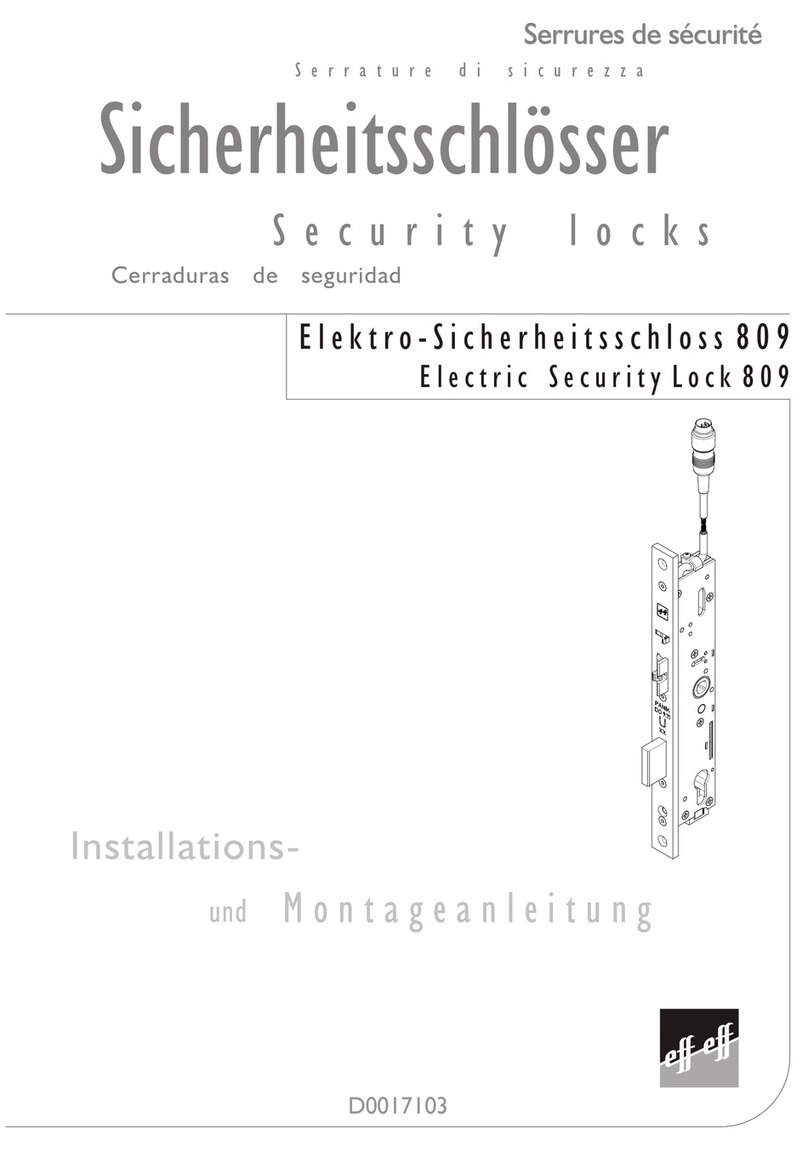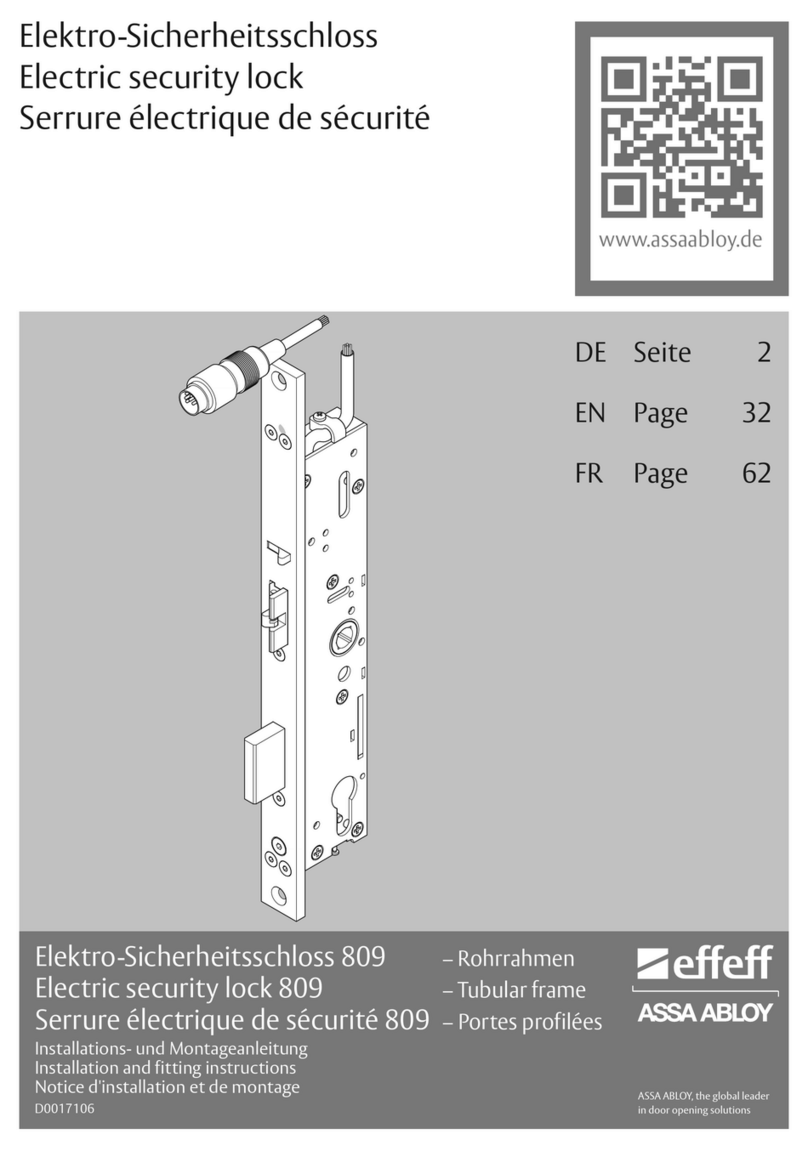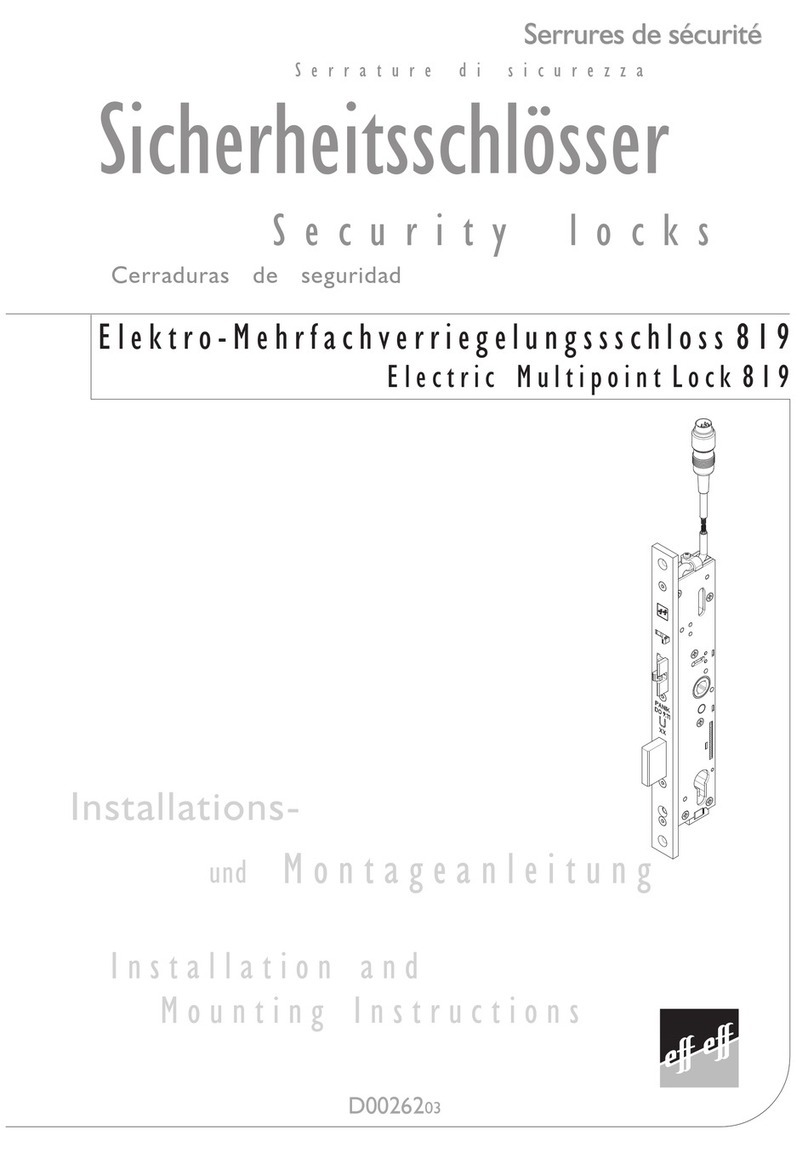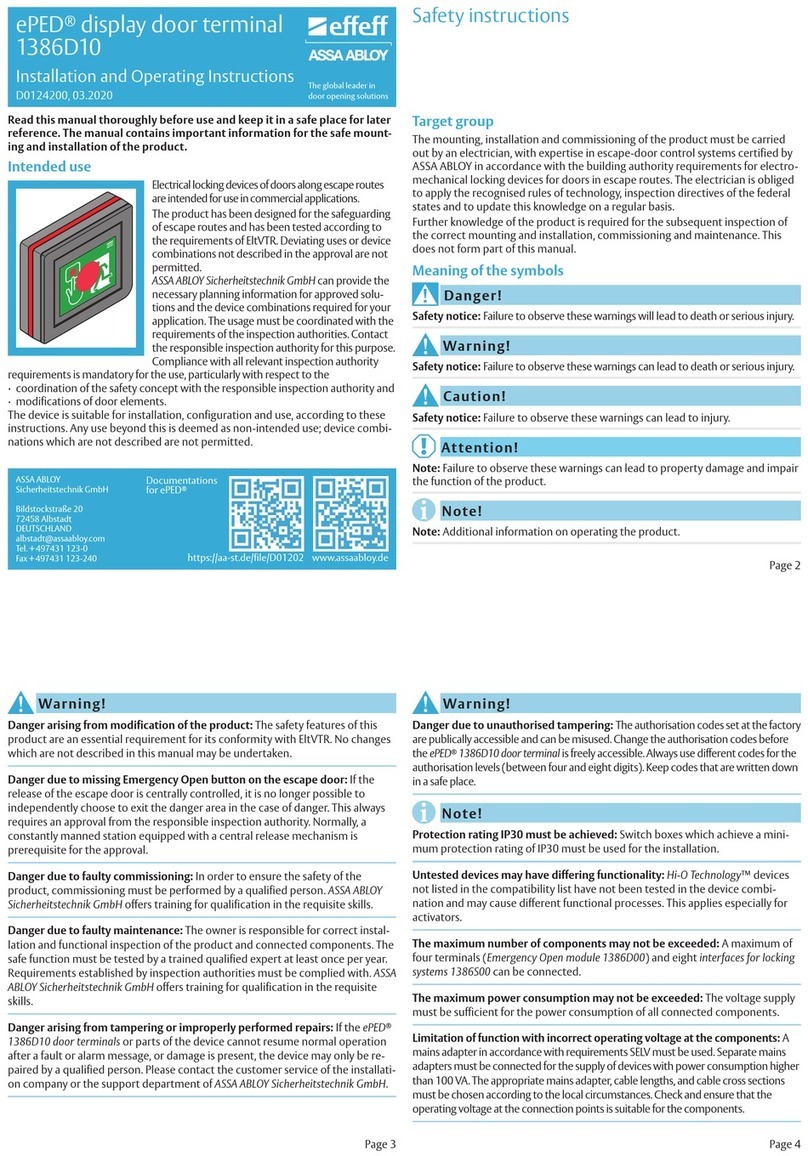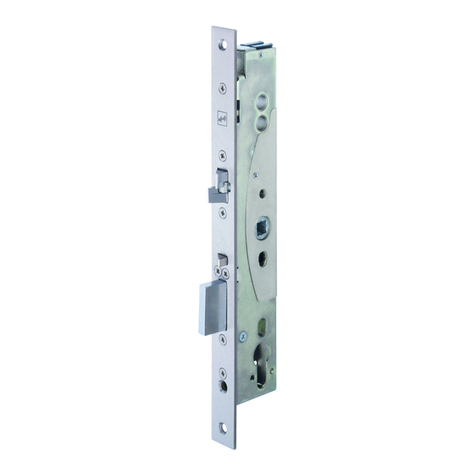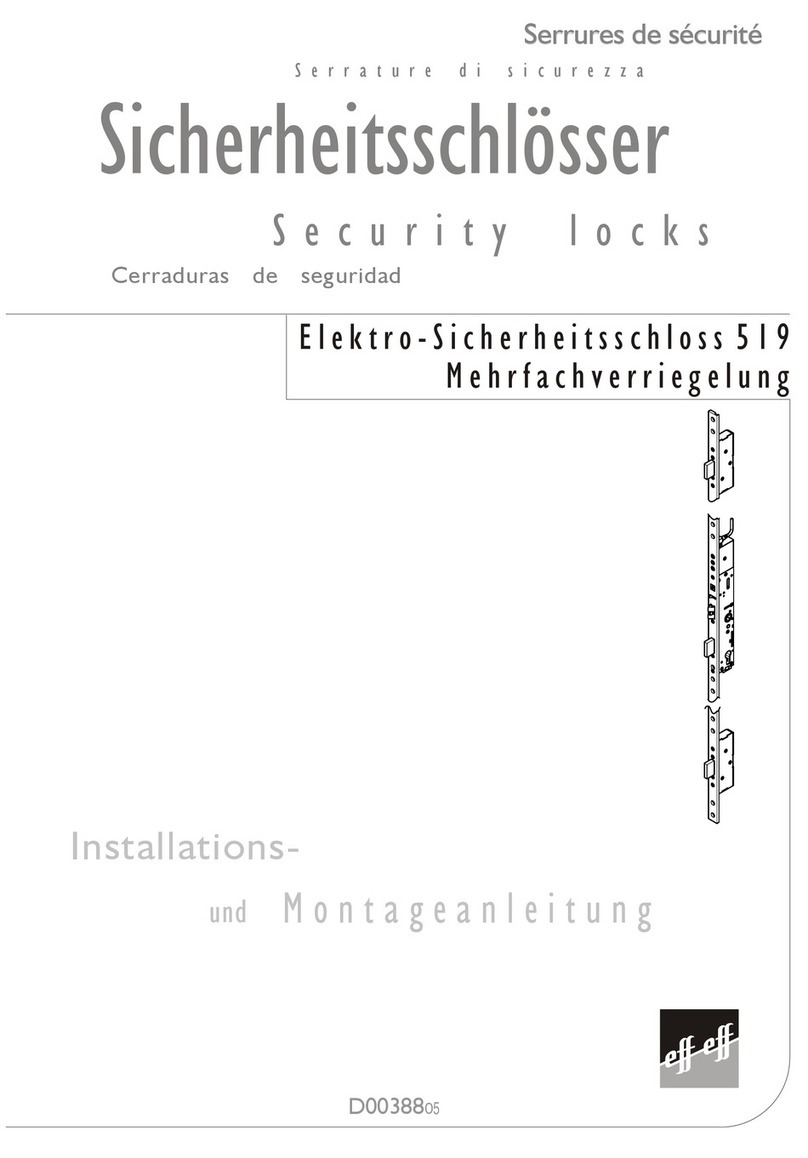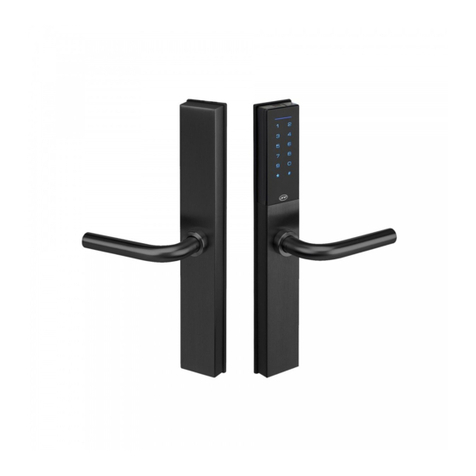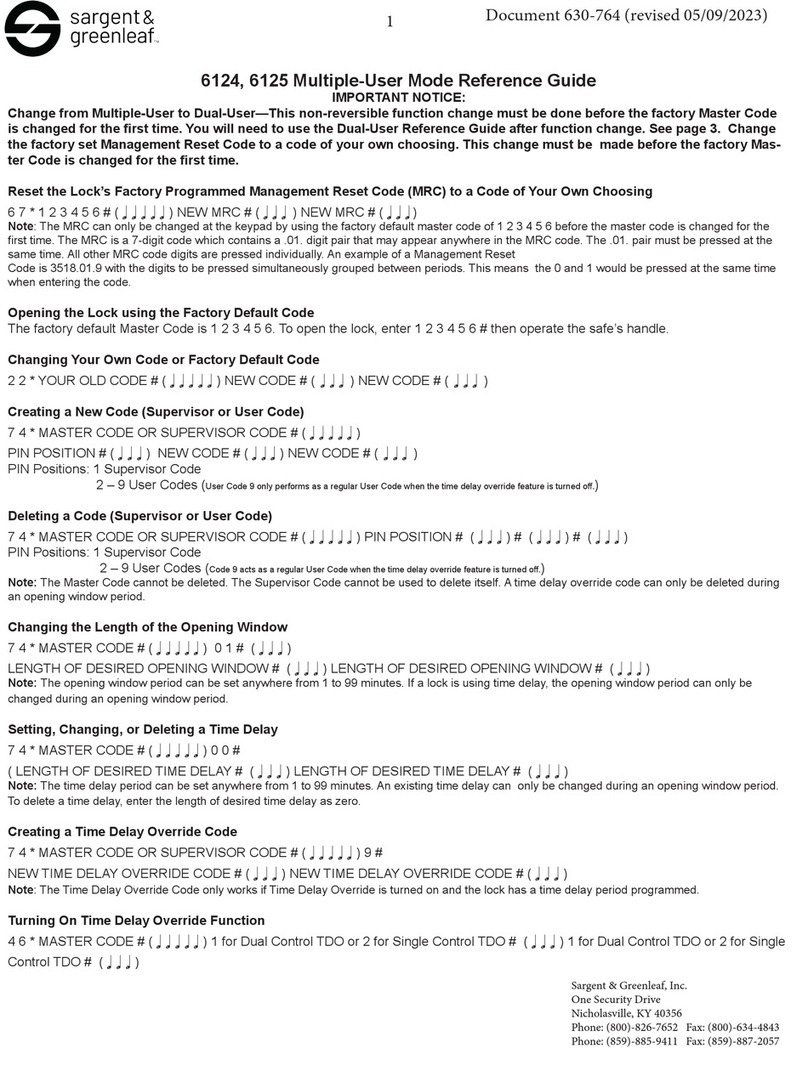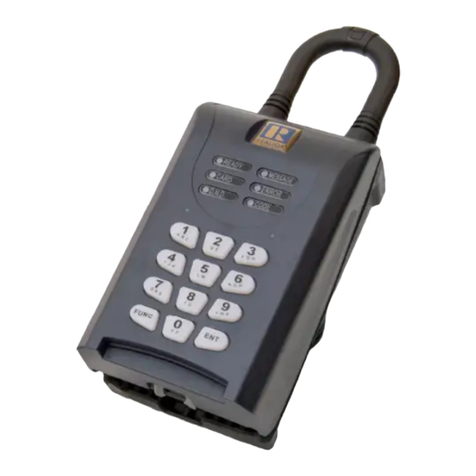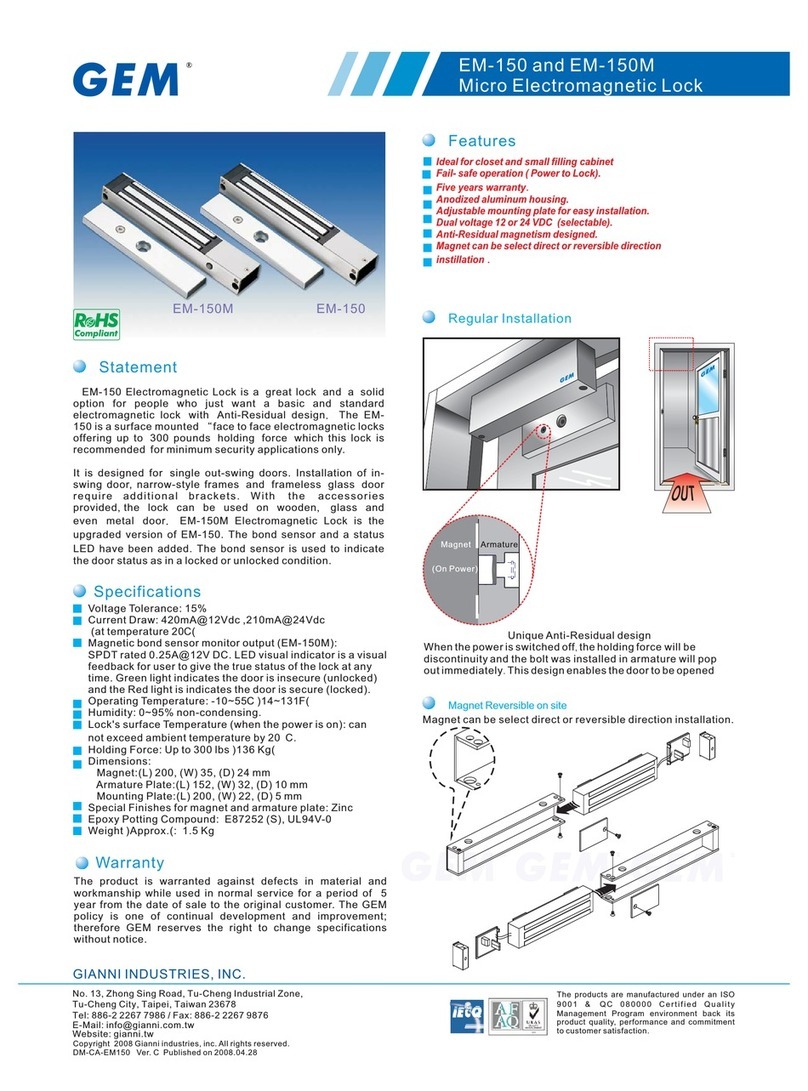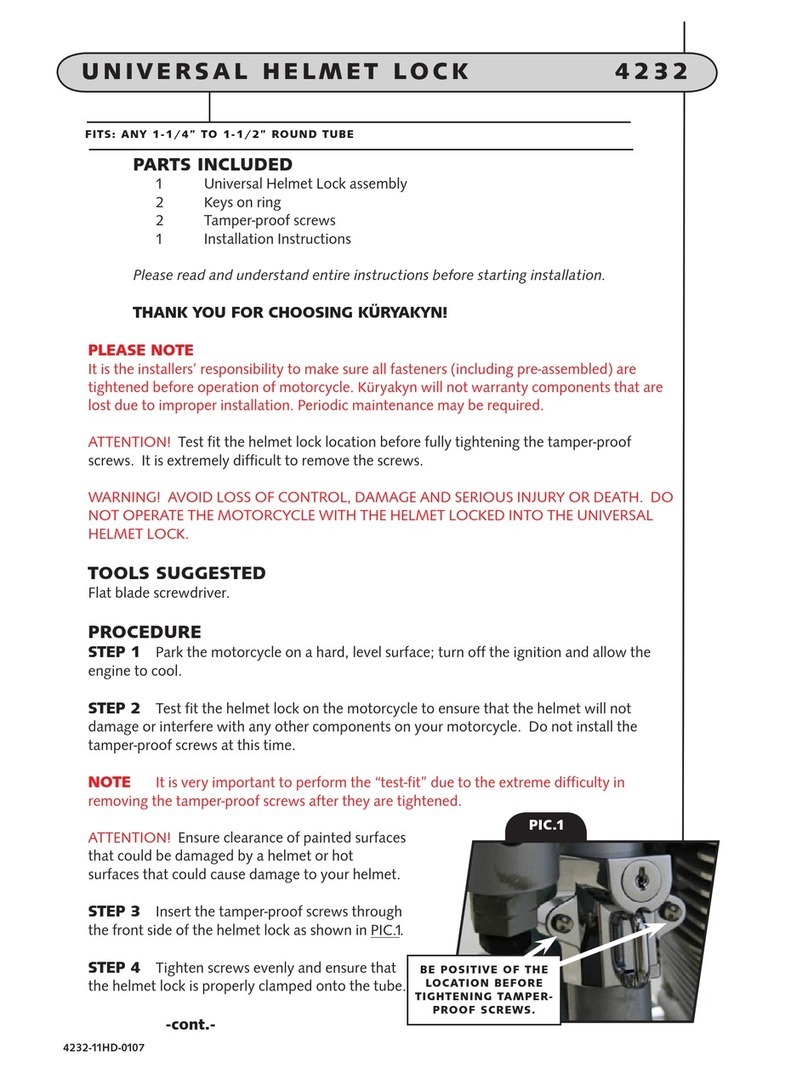effeff 421-40-10 User manual

Sicherheit und Präzision
Mini - Türcodegeräte
Mini Door Code Units
421-40-10
421-41
421-42-10
421-43
Bedienungsanleitung
Operating Instruction
D00157
05

ON
12345678
123456789
123456789
ON
12345678
Leiterplattenansicht
Taster bzw. Kontaktstifte zum durch-
führen eines "Code-Resets". Der Code-
Reset wird durch Betätigen des Tasters
bzw. durch kurzzeitiges Überbrücken
der Kontaktstifte ausgelöst.
DIP-Schalterblock zur Auswahl der Betriebsart sowie zur Einstellung
der Teilnehmeradresse in der Betriebsart Busteilnehmer.
Einzelgerät --> DIP-Schalter 8 in Stellung OFF
Busteilnehmer --> DIP-Schalter 8 in Stellung ON
Teilnehmeradresse --> Einzustellen mit den DIP-Schalter 1-7
JP 2
Technische Daten
Betriebsnennspannung 12 V DC
Eingangsspannungsbereich 8 - 20 V DC 50% Restwelligkeit
Stromaufnahme des Gerätes 15 mA typisch bei Nennspannung
Stromaufnahme des Gerätes
bei aktivem Relais 50 mA bei Nennspannung
Kontaktbelastbarkeit max.1 A 24V DC ohmsche oder
induktive Last
Betriebstemperatur Modelle 421-40/42-10 0
0
C - 40
0
C IP 30
Modell
421-40-10
421-42-10
Modell
421-41
421-43
2
D00157-G0000100
Betriebsnennspannung 12 V DC; +/-15%
Nennstromaufnahme 15 mA (typ.)
50 mA (Relais angezogen)
Netzteilempfehlung effeff Bestell-Nr.: 1001-12-1
Kontaktbelastbarkeit 24 V DC/1 A
Betriebstemperaturbereich 421-40/421-42-10: 0 °C bis +40 °C
421-41/421-43: -15 °C bis +40 °C

Beschreibung
Das Mini-Türcodegerät bietet die
Möglichkeit, mit geringem Auf-
wand eine Zutrittskontrolle für zu
sichernde Bereiche aufzubauen.
Die Mini-Türcodegeräte können
als Einzelgeräte oder in Ver-
bindung mit der effeff-Bus-
zentrale 900-10 als Busteilneh-
mer betrieben werden. Wird das
Mini-Türcodegerät als Einzelge-
rät verwendet, erfolgt die Be-
dienung sowie die Program-
mierung der Codes am Mini-
Türcodegerät. Bei der Verwend-
ung als Busteilnehmer, erfolgt
die Programmierung ausschließ-
lich durch die Buszentrale.
Installation
Alle Anschlußarbeiten am Gerät
und Verriegelungselement müs-
sen gemäß Anschlußplan durch-
geführt werden. Die Stromver-
sorgung für das Mini-Türcode-
gerät und das Verriegelungsele-
ment mußdurch ein Gleich-
richtergerät mit einer Ausgangs-
spannung von 12 VDC oder
durch die Buszentrale erfolgen.
Für die Installation sollten nur
abgeschirmte Leitungen mit ei-
nem geeigneten Leitungsquer-
schnitt verwendet werden.
Das Gerät mußan dem dafür
vorgesehenen Erdungsbolzen
geerdet und die Leitungsschirme
daran angeschlossen werden.
Störungen
Die Mini-Türcodegeräte sind ge-
gen externe Störeinflüsse ge-
schützt. Um die Betriebssicher-
heit noch weiter zu erhöhen,
sollte das Gerät nicht extremen
Störfeldern ausgesetzt werden.
Sollte das Gerät infolge starker
Störungen dennoch nicht mehr
funktionieren, so ist dieses für
ca. 30 Sekunden von der
Versorgungsspannung zu tren-
nen und anschließend wieder
einzuschalten.
Verriegelungsteile
Das Mini-Türcodegerät stellt ei-
nen potentialfreien Relaiskontakt
zur Ansteuerung eines Verbrau-
chers zu Verfügung. Für den
Standartbetrieb sind folgende
Verriegelungselemente vorge-
sehen.
Arbeitstromöffner
1405 und 1705 100% ED
Nennspannung 12 V-
(Spannungsbereich 11 - 13 V-)
Stromaufnahme: 1405 -> 200mA
1705 -> 230mA
Ruhestromöffner
3405 und 3705 100% ED
Nennspannung 12 V-
(Spannungsbereich 11 - 13 V-)
Stromaufnahme: 3405 -> 200mA
3705 -> 230mA
Diese Türöffnertypen sind mit
Freilaufdioden ausgestattet, die
Stör- und Abschaltspitzen kurz-
schließen. Werden andere Ver-
braucher als die oben aufge-
führten angesteuert, sind diese
ebenfalls durch eine Freilauf-
diode bzw. durch andere geeig-
nete Maßnahmen zu entstören.3

Montage
Bei Aufputzgeräten mußzuerst
der Gehäuseboden an einer ge-
eigneten Stelle, vorzugsweise
neben dem Türrahmen, befestigt
werden. Wird die Unterputzaus-
führung verwendet, so ist zu-
nächst die Kunststoff-uP-Dose in
der Wand zu befestigen und
einzuputzen sowie die Zuleitun-
gen durch die Kabeldurchführ-
ungen zu führen. Anschließend
ist der Blendrahmen und der
Geräteboden mit der Kunststoff-
uP-Dose zu verschrauben.
Beachten Sie, daßbei der Mon-
tage keine Leitungen oder Rohre
in der Wand beschädigt werden.
Außerdem ist darauf zu achten,
daßdas Gehäuse sowie die Be-
festigungsschrauben keine Ver-
bindung zu leitenden Teilen in
der Baukonstruktion haben, um
Störeinflüsse zu vermeiden.
Montageset 41412-1:
Bestehend aus Einputz-
dose und Blendrahmen.
Wird bei den Unter-
putzgeräten 421-42-10
und 421-43 mitgeliefert.
Modelle 421-41/43
Modelle 421-40/42-10
4
D00157-G0000200

Freigabekontakt
Wird das Mini-Türcodegerät als
Einzelgerät betrieben, kann an
den Klemmen 6 und 7 ein Kon-
takt angeschlossen werden, mit
dem die Tür für die Freigabezeit
(Taster) bzw. für die Dauer der
Ansteuerung (Schalter) entriegelt
werden kann.
Inbetriebnahme
als Einzelgerät
Nachdem alle Montage- und An-
schlußarbeiten durchgeführt wur-
den, kann das Gerät in Betrieb
genommen werden. Gehen Sie
dabei wie folgt vor:
Schalten Sie die Stromversor-
gung für das Gerät ein.
Führen Sie einen Code-Reset
durch, um alle eventuell pro-
grammierten Codes zu löschen
und den Änderungscode auf die
Werkseinstellung 0 0 0 0 einzu-
stellen.
potentialfreier
Wechselkontakt
(Freigaberelais)
Türöffnertaster bzw.
Rückmeldekontakt
bei Busbetrieb
Spannungs-
versorgung
123456789
+
_
12 VDC
230 VAC
Busleitung
Arbeitstromöffner
Ruhestromöffner
+_
Anschlußplan
Verriegelungsteil
Überprüfen Sie die Funktion des
Gerätes und des angeschlos-
senen Verriegelungsteils durch
die Eingabe des Änderungs-
codes 0 0 0 0.
Verwendung am TS-Bus
Das Mini-Türcodegerät kann als
Busteilnehmer am TS-Bus be-
trieben werden. Dazu mußder
DIP-Schalter 8 in Stellung ON
gebracht und mit den DIP-
Schaltern 1-7 die Teilnehmer-
adresse des Gerätes eingestellt
werden. Zusätzlich mußan den
Klemmen 8 und 9 die Busleitung
zur Zentrale angeschlossen
werden.
Beim Anschlußder Busleitung ist
unbedingt auf die richtige Po-
larität zu achten.
Bei der Verwendung als Bus-
teilnehmer mußan den Klem-
men 6 und 7 ein Rückmeldekon-
takt angeschlossen werden. Mit
diesem Kontakt wird überwacht,
ob die Tür geschlossen ist (Tür
geschlossen - Kontakt geschlos-
sen). Steht kein Kontakt zur
Verfügung, müssen die Klem-
men 6 und 7 verbunden werden.
Zusätzliche Hinweise zur Instal-
lation und zum Betrieb am TS-
Bus sowie zur Einstellung der
Teilnehmeradresse entnehmen
Sie bitte der Bedienungsanleit-
ung, die der Buszentrale beiliegt.
5
D0V
D00157-A0000100

Programmierung
Änderungscode:
Der Änderungscode kann zur
Freigabe der Tür genutzt wer-
den, und ist erforderlich, um die
Benutzercodes zu programmie-
ren. Programmiert wird der Än-
derungscode, indem der mo-
mentan gültige Änderungscode
eingegeben und innerhalb von
3 Sekunden der Programmier-
modus durch Betätigen der
Taste "-" aktiviert wird.
Anschließend kann der neue
4-stellige Code eingegeben wer-
den. Beendet wird der Program-
miervorgang durch Betätigen
der Taste "+". Für den gesam-
ten Programmiervorgang stehen
maximal 13 Sekunden zur Ver-
fügung. Ist die Programmier-
ung nicht innerhalb dieser Zeit
abgeschlossen, wird der Pro-
grammiervorgang abgebrochen
und der bisher gültige Code
bleibt erhalten.
Benutzercode:
Es stehen drei 4-stellige Benut-
zercodes zur Verfügung, die mit
dem Änderungscode program-
miert werden können. Program-
miert werden die Benutzer-
codes, indem zunächst der Än-
derungscode eingegeben wird,
gefolgt von der Taste "-". An-
schließend ist der Index des Be-
nutzercodes einzugeben z.B. "1"
für den ersten bzw. "2" oder "3"
für die weiteren Benutzer-
codes, wiederum gefolgt von der
Taste "-".
Danach kann der 4-stellige Be-
nutzercode eingegeben und die
Programmierung durch Betätigen
der Taste "+" abgeschlossen
werden. Für den gesamten Pro-
grammiervorgang stehen wieder
maximal 13 Sekunden zur
Verfügung.
Freigabezeit
Die Freigabezeit nach Eingabe
eines gültigen Codes beträgt
3 Sekunden.
Dauerentriegelung
Mit der Dauerentriegelungsfunk-
tion besteht die Möglichkeit, das
Verriegelungselement unabhän-
gig von der Freigabezeit zu ent-
riegeln. Es kann jedoch nur der
Benutzercode 1 für diese Funk-
tion verwendet werden. Dazu ist
der Code einzugeben, wobei die
letzte Ziffer um zwei erhöht wer-
den muß, ohne Übertrag auf die
nächste Stelle. Beispiel: Der
Benutzercode 1 sei "1234", so
mußfür die Aktivierung der
Dauerentriegelung die Ziffern-
folge "1236" eingegeben werden.
Zurückgesetzt wird die Dauerent-
riegelung durch Eingabe des
Benutzercodes 1 "1234".
Falschcodeauswertung
Damit ein gültiger Code nicht
durch probieren herausgefunden
werden kann, wird die Tastatur
gesperrt, wenn nicht spätestens
mit der achten Tastenbetätigung
ein gültiger Code vollständig ein-
gegeben ist. Die Sperrung der
Eingabetastatur beträgt 30 Se-
kunden.
6

Programmierbeispiel
Löschen
aller programmierten Codes
durch Betätigen des Tasters oder
brücken der Kontaktstifte "Code-Reset"
Programmierung eines neuen
Änderungscodes.
Eingabe des aktuell gültigen
Änderungscodes
Programmiermodus
einleiten
Eingabe des neuen Änderungscodes
Programmiermodus
beenden
0000
7530
+
1236
1234
Programmieren eines Benutzercodes
am Beispiel des "Benutzercodes 1".
Eingabe des Änderungscodes
Programmiermodus
einleiten
Index für "Benutzer-
code 1" eingeben
Verzweigung zur
Codeeingabe
Eingabe des gewünschten
"Benutzercodes 1".
Programmiermodus
beenden
7530
+
3
1
214
7530
1 2 3
oder
,
Benutzercode- Index
Es stehen
drei programmierbare Benut-
zercodes zur Verfügung, denen die
Indizes 1, 2 und 3 zugewiesen sind. Bei
der Programmierung der Benutzer-
codes ist der entsprechende Index
zwischen den beiden Betätigungen der
Taste "-" einzugeben.
Dauerentriegelung mit dem
programmierten "Benutzercode 1"
Aktuell gültiger Benutzercodes 1
1 2 3 4
Eingabe des Dauerentriegelungscodes
Zurücksetzen der Dauerentriegelung
durch Eingabe des "Benutzercodes 1"
7
,
JP 2
421-40/42-10 421-41/43

8

Operating Instructions
9

ON
12345678
123456789
123456789
ON
12345678
View printed circuit board
Push button or contact pin for making a
"code reset". The code reset is
triggered by operating the push button
or by briefly bridging the contact pins.
DIP switch block for selection of the operating mode and for setting
the address when operating in a Bus system.
Stand alone --> DIP-switch 8: position OFF
Bus operation --> DIP-switch 8: position ON
Bus address --> to be set via DIP-switches 1-7
JP 2
Technical Data
Nominal operating voltage 12 V DC
Input voltage range 8 - 20 V DC 50% residual ripple
Current consumption of the unit 15 mA typical at nominal voltage
Current consumption of the unit
when relay is activated 50 mA at nominal voltage
Contact load capacity max.1 A 24V DC ohmic or
inductiv load
Operating temperature Models 421-40/42-10 0
0
C - 40
0
C IP 30
Models 421-41/43 -15
0
C - 40
0
C IP 42
Model
421-40-10
421-42-10
Model
421-41
421-43
10
D00157-G0000100
Nominal operating voltage 12 V DC; +/-15%
Nominal
Current consumption 15 mA (typical)
50 mA (relay is activated)
Recommended
power supply effeff Order-Nr.: 1001-12-1
Contact load capacity 24 V DC/1 A
Operating
temperature range 421-40/421-42-10: 0 °C bis +40 °C
421-41/421-43: -15 °C bis +40 °C

Description
The mini door code unit offers
the possibility to easily install an
access control system for areas
which have to be protected. Mini
door code units can be operated
as individual devices or as Bus
parties in connection with the
effeff Bus central unit 900-10.
If the mini door code unit is used
as an individual device,
operation and programming of
the codes is carried out at the
mini door code unit itself. If it is
used as a party to the Bus,
programming can only be
effected via the Bus central unit.
Installation
All connections at the unit and
the locking element must be
carried out in accordance with
the connection diagram. Current
supply for the mini door code
unit and the locking element
must be provided by means of a
rectifier unit with an output
voltage of 12 V DC or by means
of the Bus central unit.
Regarding the installation, only
shielded wires with suitable
cross section shall be used.
The unit must be earthed at the
earthing bolts provided and the
wire shields must be connected
to it.
Interferences
The mini door code units are
protected against external
interferences. In order to further
increase the operational
reliability the unit shall not be
subjected to extreme inter-
ference fields. In case con-
siderable interferences cause the
failure of the unit, it must be
disconnected from the supply
voltage for approx. 30 seconds
and then be switched on again.
Locking parts
The mini door code unit provides
a potential free change-over
relay contact for triggering of a
consumer. Following locking
elements are intended to be
used for standard operation.
Fail-locked strikes
1405 and 1705
100 % continuous duty
Nominal voltage 12 V DC
(Voltage range 11 - 13 V DC)
Current consumption:
1405 -> 200mA 1705 -> 230mA
Fail-unlocked strikes
3405 und 3705
100% continuous duty
Nominal voltage 12 V DC
(Voltage range 11 - 13 V DC)
Current consumption:
3405 -> 200mA 3705 -> 230mA
These strike models are
equipped with recovery diodes
which short-out interference
peaks and cutoff spikes. In case
consumers not mentioned above
shall be triggered, a recovery
diode must be provided or other
suitable measures have to be
taken to guarantee interference
protection.
11

Mounting
With regard to surface mounting
version, first of all the bottom of
the housing must be fixed in a
suitable position, preferably next
to the door frame. In case a flush
mounting version is used, the
corresponding plastic housing
must be fixed in the wall first.
Then the plaster work has to be
done and the supply lines have
to passed through the
cable
bushings. Afterwards the frame
and the bottom of the unit have to
be connected with the plastic
flush mounting housing by
screws. Please take care that no
leads or tubes inside the wall are
damaged when mounting the
unit. Furthermore it must be
ensured that there is no
connection between the housing
or the fixing screws and
conducting parts in the
construction of the building in
order to avoid interferences.
Mounting set 41412-1:
Consists of housing for
flush mounting and
frame. Is supplied with
flush mounting units
421-42-10 and 421-43.
Modelle 421-41/43
Modelle 421-40/42-10
12
D00157-G0000200

Release contact
If the mini door code unit is used
as an individual device it is
possible to connect a contact to
terminals 6 and 7 by means of
which the door can be unlocked
during the release period (push
button) or during triggering
(switch)
Initial operation as an
individual device
After all mounting and installation
works have been carried out the
unit can be set into operation.
Please proceed as follows:
Switch on the power supply for
the unit.
Carry out a code reset in order to
delete any codes that might be
programmed and to set the
modification code to
the factory
setting "0 0 0 0".
+_
Connection Diagram
o
Check the function of the unit
and of the connected locking part
by input of the modification code
"0 0 0 0".
Use at the TS-Bus
The mini door code unit can be
operated as a Bus party at the
TS-Bus. The DIP switch 8 must
be in position ON and the Bus
address of the unit must be set
by means of the DIP switches
1-7. Additionally, the Bus wire to
the central must be connected to
the terminals 8 and 9.
When connecting the Bus it is
imperative to guarantee correct
polarity of the two wires.
In case the unit is used as a Bus
party, a monitoring contact must
be connected to the terminals
6 and 7. By means of this contact
it is possible to monitor if the
door is closed (door closed
contact closed). If no contact is
available, the terminals 6 and 7
must be connected.
For additional information
regarding the installation, the
operation at the TS-Bus and the
setting of the Bus address please
see the operating instructions
attached to the Bus central
unit.
13
D00157-A0000100
Locking element
Potential-free
change over
contact relay
Power supply
Fail-unlocked strike
Fail-locked strike
Release button or
monitoring contact
for Bus operation
Bus wire

Programming
Master code:
The master code can be used
for releasing the door and is
required for programming the
user codes. For programming
the master code, the master
code which is valid at the
moment must be entered and
the programming mode must be
activated within 3 seconds by
operating the key "-". Afterwards
the new 4-digit code can be
entered. Programming is ter-
minated by operating the key
"+". The complete programming
must be carried out within 13 se-
conds. In case programming is
not carried out within this period
of time, the process is
interrupted and stopped and the
previously valid code is
maintained.
User code:
Three 4-digit user codes are
available which can be pro-
grammed by the master code.
When programming the user
codes, first the master code
must be entered and then the
key "-" must be operated.
Afterwards the index of the user
code must be entered e. g. "1"
for the first one or "2" or "3" for
further user codes and the key
"-" must be operated
again.
Then the 4-digit user code can
be entered and the programming
can be terminated by operating
the key "+".
The complete programming must
also be carried out within 13 se-
conds maximum.
Release period:
The release period after entering
any valid code is 3 seconds.
Permanent unlocking:
The permanent unlocking
function offers the possibility to
unlock the locking element
regardless of the release period.
However only user code 1 can be
used for this function. The code
must be entered and the last
figure must be increased by 2
without carrying over any amount
to the next digit. Example: The
user code 1 is "1234". For
activating the permanent
unlocking mode the figures
"1236" must be entered. The
permanent unlocking mode is
reset by entering the user code
"1234".
Erroneous code evaluation:
In order to prevent that somebody
finds out a valid code by trial and
error the keypad is blocked if no
complete code has been entered
after maximum 8 key operations.
The keypad remains blocked for
a period of 30 seconds.
14

Programming example
Deleting of all programmed Codes by
operating the push button or bridging
the contact pins "code reset".
Programming of a new master code.
Entering of the master code valid at the
moment
Triggering of the
programming code
Entering of the new master code
Terminating of the
programming mode
0000
7530
+
1236
1234
Programming of a user code
Example: "User code 1"
Entering of the master code
Triggering of the
programming mode
Entering of index
for "user code 1"
Branching for entering
of the code
Entering of the desired "user code 1"
Terminating the
programming mode
7530
+
3
1
214
7530
1 2 3
oder
,
User code index
The indexes 1, 2 and 3 are assigned to
the three programmable user codes that
are available. When programming the
user codes the corresponding index
must be entered after operating the
key "-" for the first time and before
operating the key "-" for the second
time.
Permanent unlocking with the
programmed "user code 1"
User code 1 which is valid at the
moment
1 2 3 4
Entering of the code for permanent
unlocking
Resetting of the permanent unlocking
mode by entering the "user code 1".
15
,
JP 2
421-40/42-10 421-41/43

ASSA ABLOY
Sicherheitstechnik GmbH
Bildstockstraße 20
D-72458 Albstadt
Telefon +49 74 31/1 23-0
Telefax +49 74 31/1 23-240
www.assaabloy.de
An ASSAABLOY Group brand ASSA A BLOY
This manual suits for next models
3
Table of contents
Languages:
Other effeff Lock manuals
Popular Lock manuals by other brands
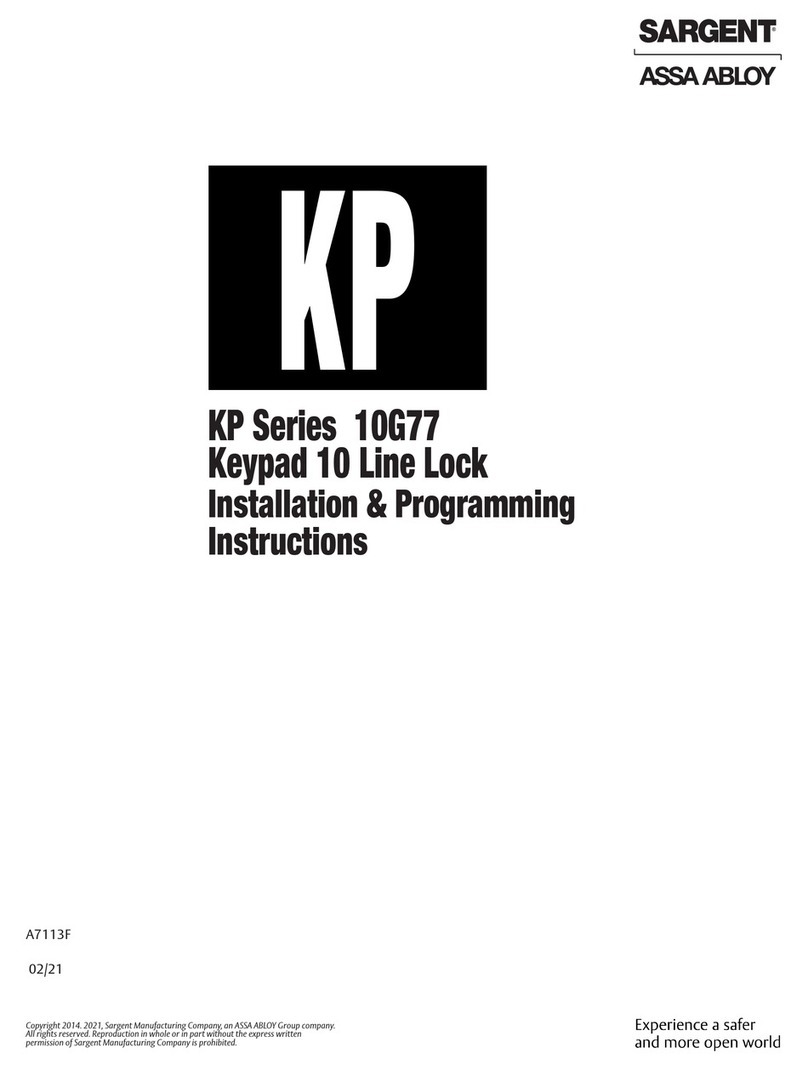
Assa Abloy
Assa Abloy Sargent KP Series Installation & programming instructions
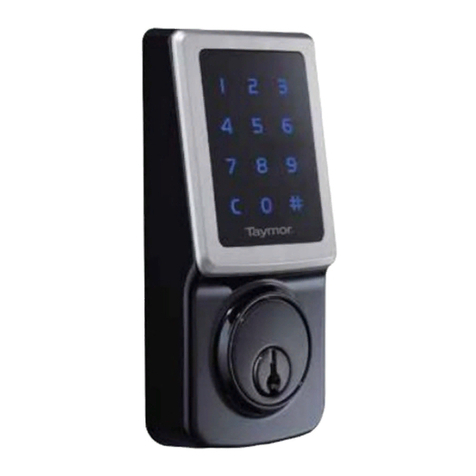
Taymor
Taymor CONCIERGE 400 PROFESSIONAL Series user guide
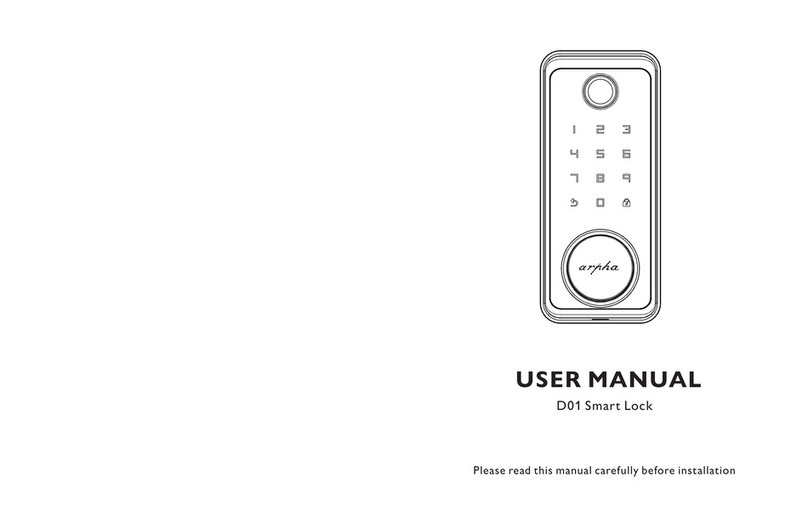
arpha
arpha D01 user manual
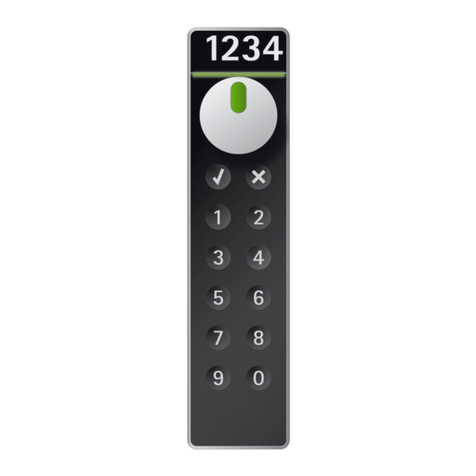
Hafele
Hafele SAFE-O-TRONIC LS 100 Mounting instructions
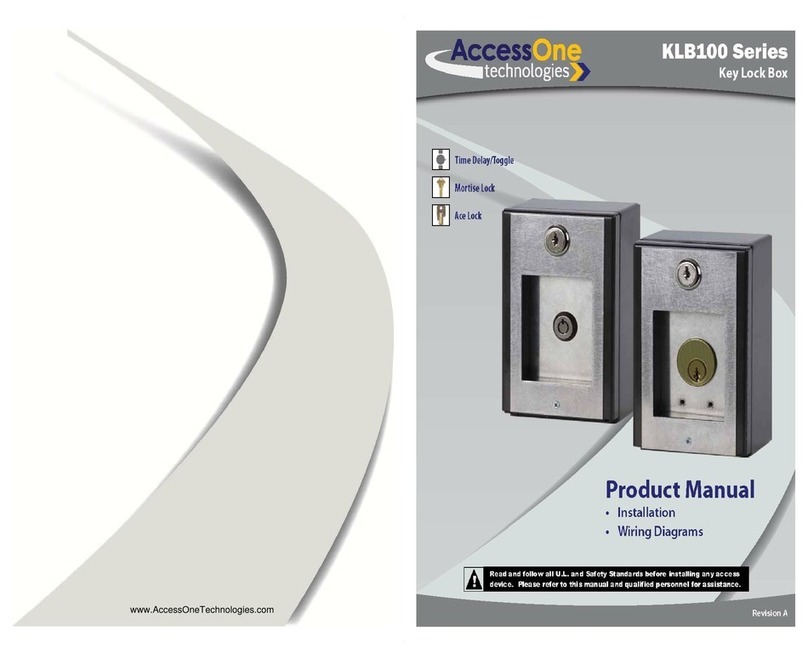
Access One
Access One KLB100 series product manual

Securikey
Securikey LA GARD 702 User instructions
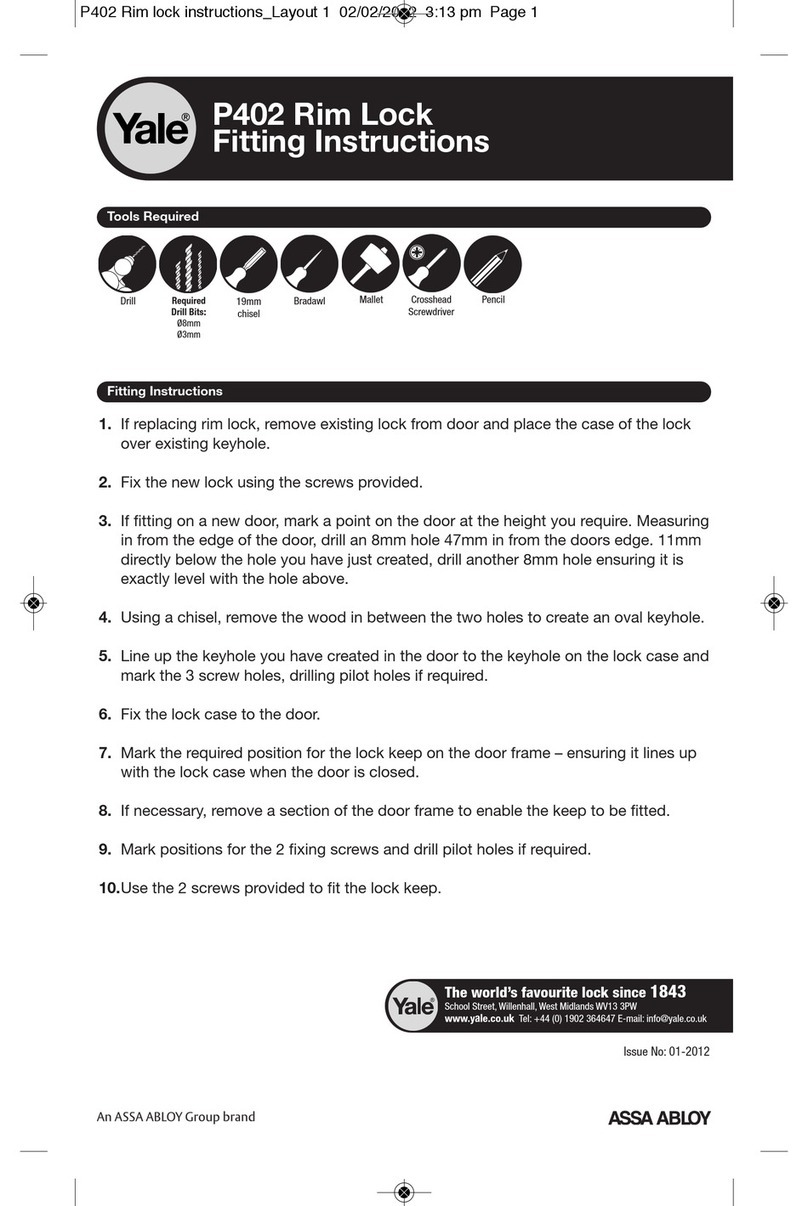
Yale
Yale P402 Fitting instructions

Major Manufacturing
Major Manufacturing HIT-30L-125 instructions

Hissmekano
Hissmekano LO-30 installation instructions
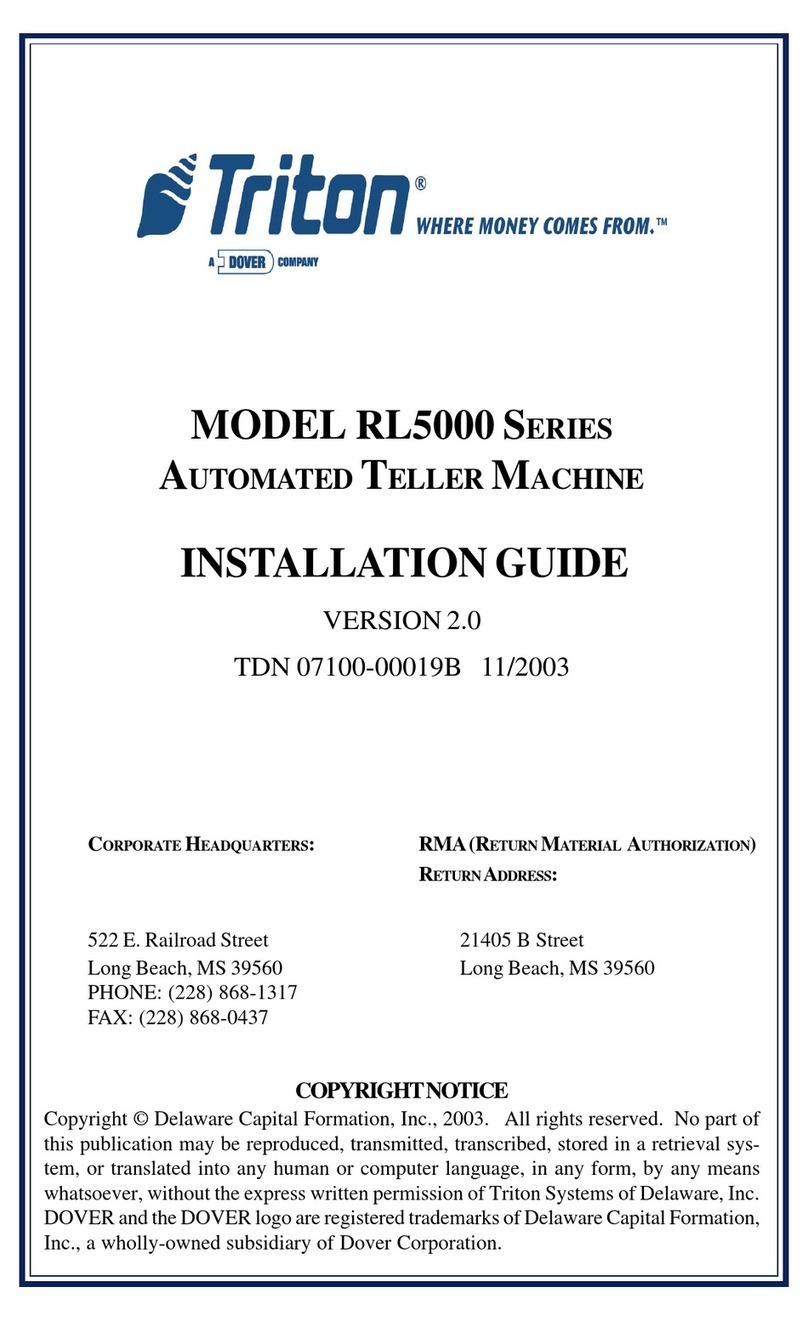
Dover
Dover Triton RL5000 Series installation guide
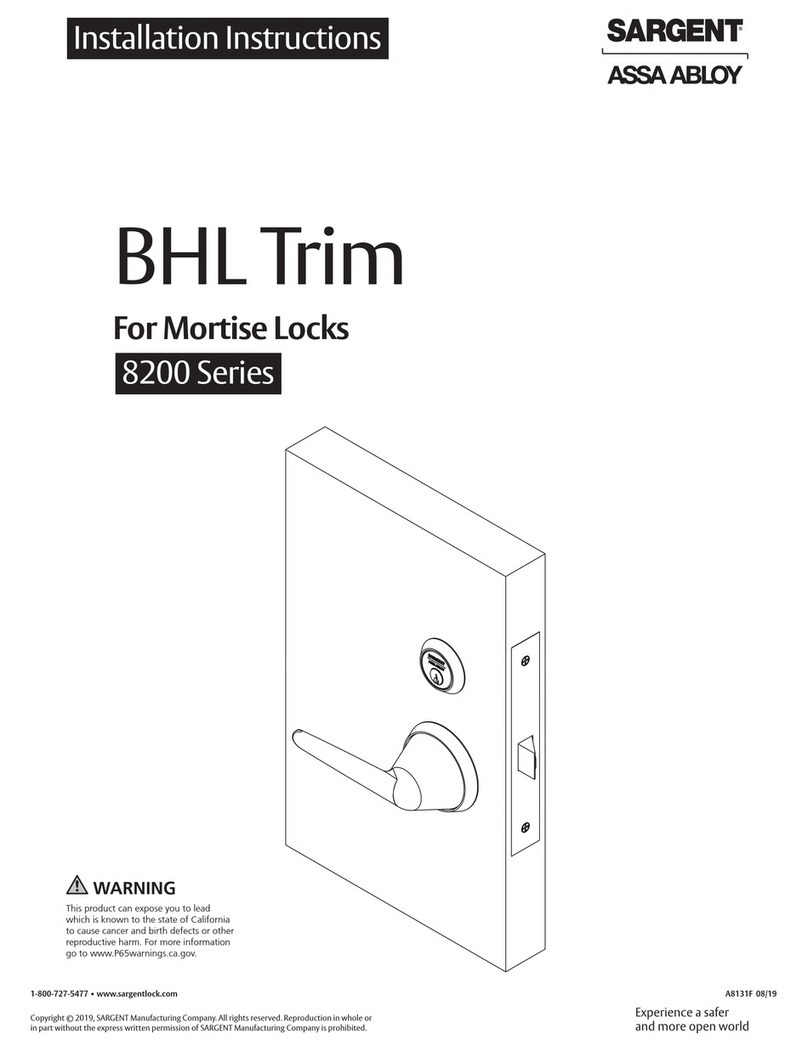
Assa Abloy
Assa Abloy Sargent 8200 Series installation instructions
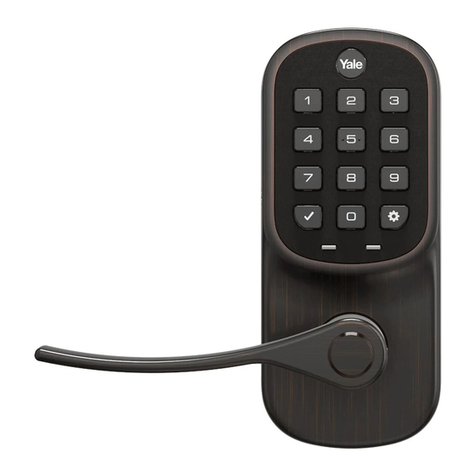
Yale
Yale Assure Lever YRL236 Installation and programming instructions
